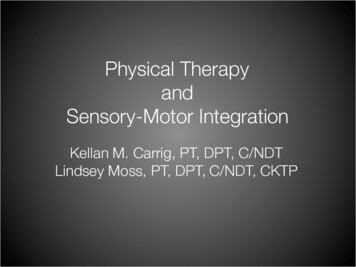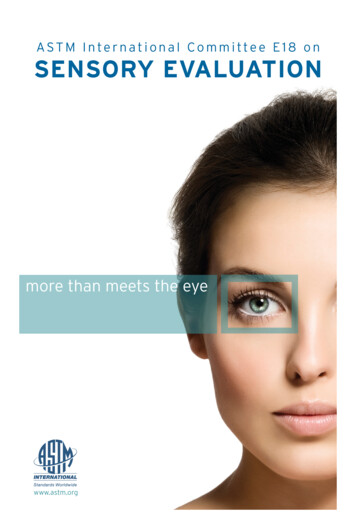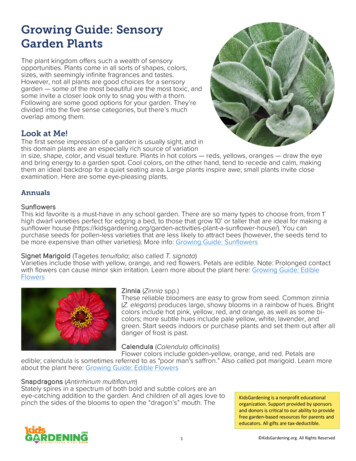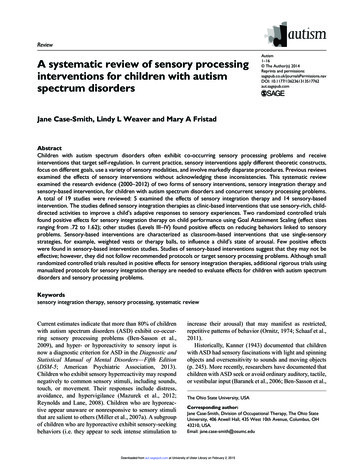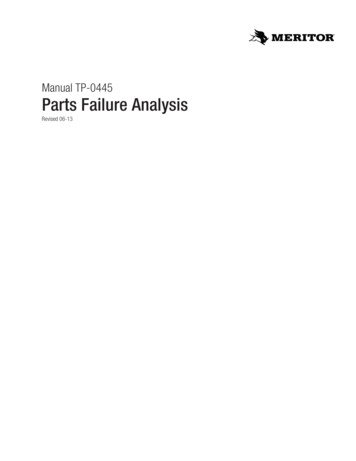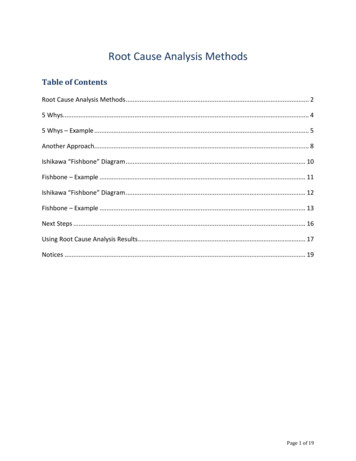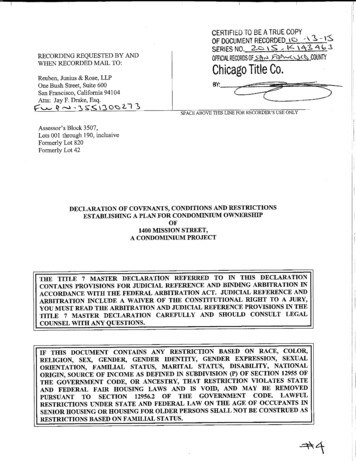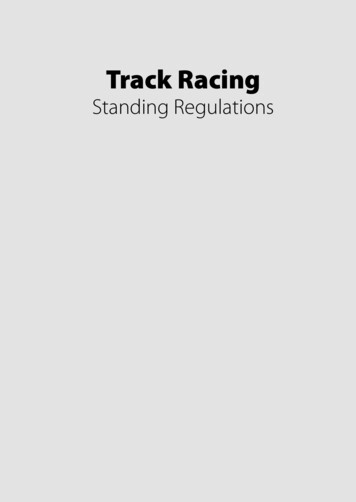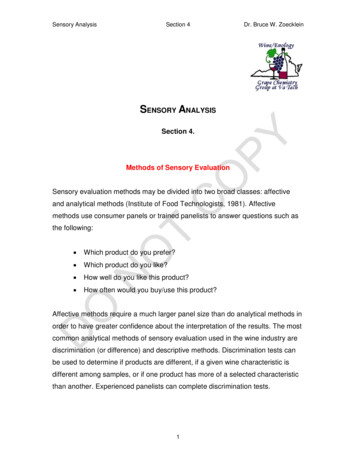
Transcription
Sensory AnalysisSection 4Dr. Bruce W. ZoeckleinSENSORY ANALYSISSection 4.Methods of Sensory EvaluationSensory evaluation methods may be divided into two broad classes: affectiveand analytical methods (Institute of Food Technologists, 1981). Affectivemethods use consumer panels or trained panelists to answer questions such asthe following: Which product do you prefer? Which product do you like? How well do you like this product? How often would you buy/use this product?Affective methods require a much larger panel size than do analytical methods inorder to have greater confidence about the interpretation of the results. The mostcommon analytical methods of sensory evaluation used in the wine industry arediscrimination (or difference) and descriptive methods. Discrimination tests canbe used to determine if products are different, if a given wine characteristic isdifferent among samples, or if one product has more of a selected characteristicthan another. Experienced panelists can complete discrimination tests.1
Sensory AnalysisSection 4Dr. Bruce W. ZoeckleinDescriptive methods are used to provide more-comprehensive profiles of aproduct by asking panelists to identify the different characteristics within theproduct and quantify characteristics. Trained panelists must be used fordescriptive methods (see Trained Panelists and Panelist Training).Discrimination (Difference) TestsDifference testing is used to determine if different winemaking processingtechniques or operations have a sensory impact. As such, difference testingmethods generally provide the winemaker with the practical information needed.They are the most feasible for use in a winery environment, and are simple androbust.There are many other sensory methods available, including consumer preferenceand acceptance tests, and descriptive analysis. However, performing some ofthese more-elaborate tests may not be feasible in small- to medium-sizedwineries. They are available through sensory service companies.Difference testing is a way to determine if a sensory difference actually existsbetween samples. The degree or nature of the difference cannot be quantified,however. Descriptive tests are generally needed to truly define differences. Thereare four types of difference tests which can be used to answer some practicalquestions. The most common for use in the wine industry are the triangledifference test and the duo-trio difference test: triangle: “Is a particular lot made with rot-compromised fruit differentfrom other lots?” duo-trio: “Is there a sensory difference among wines fermented withdifferent yeasts?”2
Sensory Analysis Section 4Dr. Bruce W. Zoeckleinpaired comparison: “Does the high VA in this wine impact itsensorially?”A brief description of the methodology of these procedures, including how toperform the tests, the number of tasters required, and the required result forconcluding that a significant difference truly exists, is outlined in Table 1. Once adifference has been established, another more elaborate test, such as apreference test, can also be performed.Difference tests are sometimes applied in a crude fashion at the winery whereonly one or two tasters perform the evaluation. While better than no testing at all,to achieve a statistically-significant sensory result, a slightly more advancedprocedure should be carried out using the minimum number of tasters, assuggested in Table 1.Generally, the larger the number of evaluators, the better. However, even a smallpanel of 5-7 will provide highly-valuable information that will greatly increasereliability and consistency of production decisions based on sensory assessment.Table 1 provides the number of correct responses for various tests to bestatistically viable at the 95-percent confidence limit. This means that there is buta 5% chance that these results are simply due to random error.Using a panel, as opposed to a single taster or two, reduces the risk ofconcluding there is no difference among wines, when one actually exists. Anynumber of panelists can be used, and the more tasters, the better. For anoverview of wine sensory evaluation, and to determine the number of correctresponses required for a significant result for any number of tasters, seeZoecklein et al. (1999 and 2005).3
Sensory AnalysisSection 4Dr. Bruce W. ZoeckleinTable 1. Outline of Sensory Difference and Preference TestsTestMin.tasters1UseSamplesBasic methodResults: are the winessignificantly different?Triangle5MultipurposeThree coded test samples.Two are the same wine(A) (but are codeddifferently).One is a different wine(B).Tasters assess all three samples,then pick the sample which isdifferent from the other two, orthe odd one out.Correct response - taster picksthe odd one out.Comparisonto areferencewineOne reference sample(Ref).Two coded test samples(A,B).A is the same wine as thereference (control wine).B is the wine to test.Tasters assess the reference(Ref), then the two test samples(A,B).Tasters are asked to indicatewhich test sample is the same asthe reference.When adifference isknownTwo coded test samples(A,B).One is known to bechemically higher in anattribute (e.g., sweetness).Duo-trioPairedcomparison77Serving orders3: AAB, ABA,BAA, BBA, BAB, ABBServing orders: Ref AB, Ref BATasters are asked to identifywhich sample is higher in anattribute (e.g., identify whichsample is sweeter).Serving orders: AB, BASame/differentPairedpreference77When adifference isunknownWhich wineis preferredTwo coded test samples(A,B).Two coded test samples(A,B).Tasters assess both samples andindicate whether they thinksamples are the same or aredifferent.Serving orders: AB, AA, BA,BB(Note: two serving orders arepresented to each taster)Tasters assess both samples andindicate which one they prefer.A choice must be made; thetaster can’t say they preferneither.Significance - Required no. ofcorrect/total responses2:Single tasting 4/5 5/6 5/7 6/8Repeated tasting 7/10 8/12 9/149/16Correct response - taster picks Aas the same as the reference.Significance - Required no. ofcorrect/total responses2:Single tasting 7/7 7/8 8/9 9/10Repeated tasting 10/12 11/1412/16 13/18Correct response - taster picksthe sample that is higher (e.g., thepresumed sweeter sample).Significance - Required no. ofcorrect/total responses2:As for Duo-trioCorrect response - tastercorrectly picks the two samples asbeing the same or different,depending on the serving order.Significance - Required no. ofcorrect/total resonses2:As for Duo-trioCount the number of people whoprefer one wine over another (e.g.,A over B).Significance - Required no.preferred A/total4:Serving orders: AB, BASingle tasting 7/7 8/8 8/9 9/10Repeated tasting 12/14 13/1614/18 15/201Indicates the minimum number of tasters required for testing to achieve a statistically significant result(p 0.05).2Figures denote minimum number of correct responses required out of the total number of responses toconclude the wines are significantly different (p 0.05) from each other.3Serving orders denotes possible arrangements of the samples to be presented randomly to tasters.4Figures denote required minimum number of tasters who agree on preference for one wine, out of the totalnumber of responses, to conclude that one wine is significantly preferred (p 0.05) over the other.Adapted from Cowey and Travis (2008).4
Sensory AnalysisSection 4Dr. Bruce W. ZoeckleinSelection of the appropriate difference test depends on many factors, includingthe following: objectives number of available tasters volume of wine availableAgain, the most common discrimination methods include the triangle test, thepaired comparison test, and the duo-trio test (ASTM, 1968; Meilgaard et al.,1991; Stone and Sidel, 1985). Although discrimination tests may be completedby a small number of panelists (10 to 12), statistical determination of differencesis more enhanced with a greater number of responses. Analysis of thesemethods is made easy by the use of statistical tables from which results of thetest may be quickly analyzed.These tests are relatively simple for the panelists if the panelists areknowledgeable about the product and characteristics of interest. In each method,the panelist is forced to make a decision or choice among the products. Theamount of information drawn from these tests is limited to a detection ofdifference. It is not possible to know the degree of differences that exist amongproducts, or if the change in the characteristic affects acceptability of, orpreference for, the product.Triangle Test. Triangle tests are useful as a multi-purpose test. The taster isrequired to select the sample which is different. Triangle tests are often preferred,as they require fewer tasters, and there is a greater likelihood that a result will begenuine and not due to a chance effect.The triangle test uses three samples to determine if an overall difference existsbetween two products. The three samples include two that are identical, and onethat is different. The samples must be coded with individual three-digit numbers5
Sensory AnalysisSection 4Dr. Bruce W. Zoecklein(derived from a random numbers table) and presented at one time to thepanelists. The panelist is requested to identify the code on the scorecardrepresentative of the odd sample.This method requires the panelist to make a choice among the samples; thepanelist has a 33% chance of simply guessing correctly. This test method hasgood applications in determining if a process change affects the overall productcharacter. Fatigue is a factor, as panelists usually must re-taste several times.Adaptation may also occur as a result of re-tasting. It is recommended that nomore than two sets (six samples) be evaluated at one testing session.Interpretation is based on the minimum number of correct responses required forsignificance at a predetermined significance level, given the total number ofresponses received. The minimum number of correct responses may be found instatistical tables provided in several publications (ASTM, 1968; Meilgaard et al.,1991; Stone and Sidel, 1985).For example, two wines processed under identical conditions are fermented inthe bottle for 6 months at two different temperatures, 7 C (45 F) and 13 C(55 F), in order to determine if the warmer fermentation temperature results in adifferent product. Twenty-four panelists evaluate the two wines, using a triangletest.A difference is wanted at a 5% level of significance (p 0.05). Fifteen of the 24panelists correctly identify the odd sample. Is there an overall difference betweenthe product fermented at 7 C, compared with the product fermented at 13 C?At the 5% level of significance with 24 panelists, a minimum of 13 correctresponses were needed to determine that there was a significant differencebetween the samples. There is a 95% or greater probability that the productfermented at 13 C is noticeably different from the product fermented at 7 C.6
Sensory AnalysisSection 4Dr. Bruce W. ZoeckleinDuo-Trio Test. Duo-trio tests are sometimes used instead of triangle tests tocompare unknown differences between wines. Tasters are presented with areference wine, and then two test wines; one wine is the same as the reference,and the other is the wine to be tested. Evaluators are asked to identify thesample that is the same as the reference wine.This test might be preferred, as the evaluator has a reference wine to compare.Generally, people find it easier to evaluate with a reference standard. It can alsobe better for assessing red wines by palate, as there is less palate fatigue. Onedisadvantage of this test, versus a triangle difference, is that more tasters arerequired (see Table 1).The reference sample may always be set as the same product (constantreference) or may be randomly chosen so that each product is represented(balanced reference). This test method is less efficient than the triangle test, witha 50% chance of guessing correctly, and requires a large amount of sample, butis frequently used when a flavor is complex or intense. Interpretation is easilydetermined from a statistical table (ASTM, 1968; Meilgaard et al., 1991; Stoneand Sidel, 1985).Paired Comparison Test. Paired comparison tests can be used when there is aknown difference in chemical composition of the wines (a simple difference test),which requires a sensory assessment. For example, a higher VA is present. Butdoes the wine have a spoilage character? Is the wine more volatile?They can also be used to see if there is a directional difference for a singlecharacteristic (“Which product is more acidic? Product 738 or Product 429?”)between the samples. This test can be useful when assessing alternative wine7
Sensory AnalysisSection 4Dr. Bruce W. Zoeckleinblends. The test requires the same amount of wine and tasters as the duo-triotest. Products are compared such that each sample is placed in the first tastingposition an equal number of times. This test causes less fatigue and is frequentlyused for strongly flavored or complex products.Whereas the triangle test provides only a 33% chance of guessing correctly,there is a 50% chance with the paired comparison test. Therefore, more panelists(at least 20) are recommended to complete this test. Interpretation is easilydetermined via a statistical table (ASTM, 1968; Meilgaard et al., 1991; Stone andSidel, 1985).Same/Different Tests. A same/different test is similar to the paired comparisontest, however, it is used when the difference between two wines is unknown.Evaluators are asked to identify whether they think the two samples presentedare the same or different. These tests are easy to set up, but more panelmembers are required, and evaluators must perform the test at least twice,receiving a different randomized serving order each time.Descriptive TestsFrequently, it is important to know how a wine changes with a new vineyard site,how intense a characteristic is, etc. Discrimination testing, which is easy to use,easy to interpret, and easy for panelists to complete, is initially used to determinethat a difference does exist. Such methods cannot provide information about thedescription of those differences, though.Descriptive evaluation methods are more difficult to complete and interpret, butprovide much more information. They provide a quantitative measure of winecharacteristics that allows for comparison of intensity between products, and a8
Sensory AnalysisSection 4Dr. Bruce W. Zoeckleinmeans of interpretation of these results. Examples of descriptive test methodsinclude quantitative descriptive analysis (QDA ), flavor profile analysis, timeintensity descriptive analysis, and free-choice profiling (Hootman, 1992;Meilgaard et al., 1991; Stone and Sidel, 1985). QDA is frequently used becauseit requires less training time than several of the other methods.Quantitative Descriptive Analysis (QDA ). QDA was developed by theTragon Corporation and the University of California, Davis. Proper QDA techniques require following strict methodology.Descriptive analysis of wines using QDA requires products with relativelysimilar characteristics. If possible, 10 to 12 panelists are selected to participatebased on ability to discriminate, communication skills, and task comprehension.Using fewer trained panelists is possible for descriptive analysis, but individualresponses have a greater effect on the mean scores.During the training, the group is provided with different wines that represent therange of characteristics that may be tested during the actual test sessions (seePanelist Training). Wine characteristics are identified, definitions or descriptionsof the characteristics are determined, and references exemplifying thecharacteristics are established. The reference standards are used to further trainthe panelists to identify the desired characteristics and learn to rate intensitylevels.A scorecard is developed by consensus of the panel that includes allcharacteristics of interest in the order in which they are to be evaluated. Eachcharacteristic is rated on a 6-inch (15.2-cm) line scale with descriptors of “weak”and “strong” as endpoint anchors. The anchor terms are located 1/2 inch (1.27cm) from each end of the line; an alternate method places vertical anchors 2.5cm from each end (Hootman, 1992). Either method is satisfactory. It is important9
Sensory AnalysisSection 4Dr. Bruce W. Zoeckleinthat panelists know they may use the entire line to mark their perception ofintensity, even those regions toward the ends of the line.Panelists continue training until the sensory specialist determines that everyoneis demonstrating comprehension of the task, and all panel members can identifyand rate each characteristic. Preliminary testing should occur to determine thereliability and validity of the individual panelists before initiating the actual testing(see Performance Evaluation).After the training is completed, the panelists function independently in theevaluation setting. No more than six or seven attributes should be evaluated ateach setting to avoid fatigue. If intense aroma characteristics are evaluated,fewer than six wine samples should be evaluated in one testing.Products are evaluated for intensity of the characteristics on the scorecard.Panelists rate the intensity of each attribute by marking a vertical mark across theappropriate horizontal rating line. These marks are converted to numerical databy measuring the distance from the origin (“weak”) of the line to the vertical mark.Sometimes only one or two characteristics are of interest, so an entire profile isnot necessary. This reduces the effort required by the panelist and the timeneeded for data handling and interpretation by the sensory specialist. A line scaleas is used for QDA is appropriate for this, or a category scale with seven tonine verbal descriptors may be used. The category scale is easier to use bypanelists with less training than a QDA panelist.Data analysis is completed using a mixed model analysis of variance fortreatment by subject, with replication (Hootman, 1992). To determine individualpanelists’ abilities to perceive differences among products, a one-way analysis ofvariance is completed for each panelist. This analysis can also be used todetermine if an attribute is helpful in differentiating among wines.10
Sensory AnalysisSection 4Dr. Bruce W. ZoeckleinSubsequent analysis, using a two-way analysis of variance design, is needed todetermine product differences and interactions by the panel (Hootman, 1992). Anindependent statistical analysis is completed for each characteristic that ismeasured.A graphic presentation, called a spiderweb plot, of all characteristics may bemade to illustrate the differences and similarities of the descriptive profiles of thewine samples evaluated. This is accomplished by plotting the mean score for agiven characteristic on an axis that represents the 15.2-cm line scale used on thescorecard (Hootman, 1992). Each axis extends from a center point like spokeson a wheel, and represents a single characteristic. The center point is equivalentto the low-intensity origin of the line scale, and the highest intensity is equivalentto the end of the axis.11
Sensory Analysis Section 4 Dr. Bruce W. Zoecklein 4 Table 1. Outline of Sensory Difference and Preference Tests 1 Indicates the minimum number of tasters required for testing to achieve a statistically significant result (p 0.05).2 Figures denote minimum number of correct responses required out of the total number of responses to conclude the wines are significantly different (p 0.05) from .
